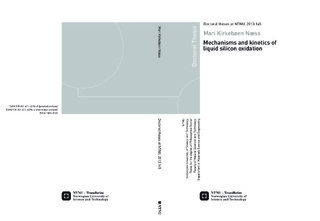| dc.contributor.author | Næss, Mari Kirkebøen | nb_NO |
| dc.date.accessioned | 2014-12-19T13:27:14Z | |
| dc.date.available | 2014-12-19T13:27:14Z | |
| dc.date.created | 2013-07-12 | nb_NO |
| dc.date.issued | 2013 | nb_NO |
| dc.identifier | 636916 | nb_NO |
| dc.identifier.isbn | 978-82-471-4394-0 (printed version) | nb_NO |
| dc.identifier.isbn | 978-82-471-4396-4 (electronic version) | nb_NO |
| dc.identifier.uri | http://hdl.handle.net/11250/249262 | |
| dc.description.abstract | The formation of silica fume when liquid metal is in contact with air during refining of metallurgical grade silicon leads to a direct loss of silicon. Apart from this yield loss the associated fume may be harmful to the workers in the plant. During tapping, refining and casting of silicon, the fume formation makes up 40 – 80 % of the fugitive emissions from the plant. In this work, the kinetics and mechanisms of fume formation during refining of metallurgical grade silicon were studied. Active oxidation is defined as the partial oxidation of Si to the gaseous product SiO. This type of oxidation does not protect the surface from further attack (passivation).When reviewing relevant literature, the majority of the research on active oxidation of silicon is done on solid silicon Research to date on liquid silicon oxidation on the other hand is primarily theoretical. As such, there is a knowledge gap concerning a mechanistic understanding of the active oxidation of liquid silicon. Boundary conditions, rate-controlling factors and flux dependencies on oxygen partial pressure and gas flow rate have not been systematically studied experimentally for active oxidation of liquid silicon. The amount of fume on an industrial scale and the characteristics of the fume such as elemental content, particle size and shape have not been adequately explored. In this project, the active oxidation of liquid silicon was investigated at three different scales; industrial measurements (~7 tonne Si); small-scale experiments 10 g Si); and medium-scale induction furnace experiments (1750 g Si). An experimental element distribution analysis of both main and trace-elements in the industrial refining ladle was performed. It was found that the amount of fume formed during industrial refining is in the range 0.7 – 1.8 kg of SiO2 per tonne silicon produced. The main mechanism of SiO2-fume formation is oxidation of the surface, so that the exposed surface area is a main parameter controlling the fume formation in the industry. The boundary conditions for the oxidation of a still Si surface were determined from the small-scale experiments. The measurements confirmed an approximated theoretical mass transfer rate of oxygen and a maximum bulk oxygen pressure for active oxidation. From the induction furnace experiments it was found that the primary factor determining the rate of fume formation is the rate of transport of oxygen to the surface, which in turn is given by the velocity of the gas above the surface. This work is the first qualitative and quantitative study containing experimental investigations from small-scale to industrial scale on the kinetic and mechanistic nature of silicon oxidation. The industrial work has also contributes to a better understanding of distribution of elements in the silicon refining process, and it gives implications for emission estimation of toxic and other trace elements to the environment. | nb_NO |
| dc.language | eng | nb_NO |
| dc.publisher | Norges teknisk-naturvitenskapelige universitet, Fakultet for naturvitenskap og teknologi, Institutt for materialteknologi | nb_NO |
| dc.relation.ispartofseries | Doktoravhandlinger ved NTNU, 1503-8181; 2013:145 | nb_NO |
| dc.relation.haspart | Næss, M.K; Tranell, G; Kamfjord, N.E.. Fugitive emissions related to oxidation of liquid silicon during ladle refining. Proceedings of the 2 nd International Symposium on High- Temperature Metallurgical Processing, TMS Annual Meeting & Exhibition, 2011. 10.10029781118062081.ch11. | nb_NO |
| dc.relation.haspart | Naess, Mari K.; Tranell, Gabriella; Olsen, Jan Erik; Kamfjord, Nils Eivind; Tang, Kai. Mechanisms and Kinetics of Liquid Silicon Oxidation During Industrial Refining. Oxidation of Metals. (ISSN 0030-770X). 78(3-4): 239-251, 2012. 10.1007/s11085-012-9303-9. | nb_NO |
| dc.relation.haspart | Naess, Mari K.; Young, David J.; Zhang, Jianqiang; Olsen, Jan Erik; Tranell, Gabriella. Active Oxidation of Liquid Silicon. Oxidation of Metals. (ISSN 0030-770X). 78(5-6): 363-376, 2012. 10.1007/s11085-012-9312-8. | nb_NO |
| dc.relation.haspart | Næss, M.K; Smith, N; Tranell, G; Olsen, J.E.. Experimental study of rate of silica formation from active oxidation of liquid silicon. Infacon XIII Congress Proceedings, 2013. | nb_NO |
| dc.relation.haspart | Næss, M.K; Kero, I.; Tranell, G.. A new method for estimation of emissions and sources of measurements error in the silicon refining process . JOM - The Member Journal of TMS. (ISSN 1047-4838), 2013. 10.1007/s11837-013-0661-9. | nb_NO |
| dc.relation.haspart | Næss, M.K; Kero, I; Tranell, G.; Tang, K.; Tveit, H.. Element distribution in silicon refining – Thermodynamic model and industrial measurements. . | nb_NO |
| dc.title | Mechanisms and kinetics of liquid silicon oxidation | nb_NO |
| dc.type | Doctoral thesis | nb_NO |
| dc.contributor.department | Norges teknisk-naturvitenskapelige universitet, Fakultet for naturvitenskap og teknologi, Institutt for materialteknologi | nb_NO |
| dc.description.degree | PhD i materialteknologi | nb_NO |
| dc.description.degree | PhD in Materials Science and Engineering | en_GB |

